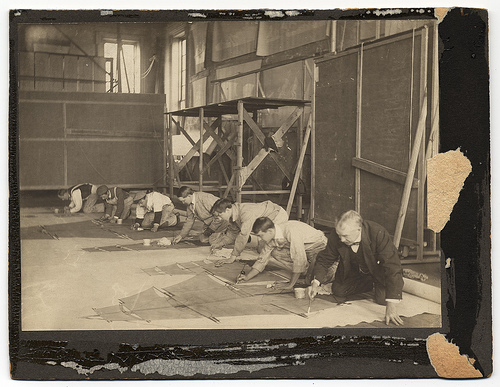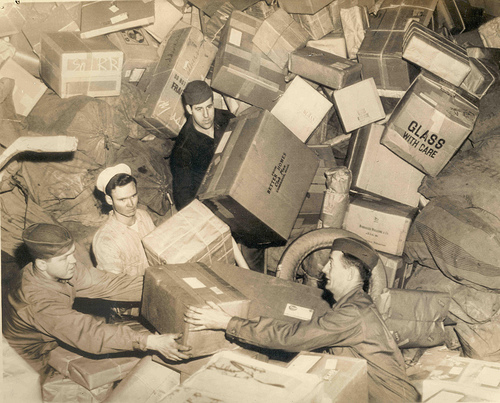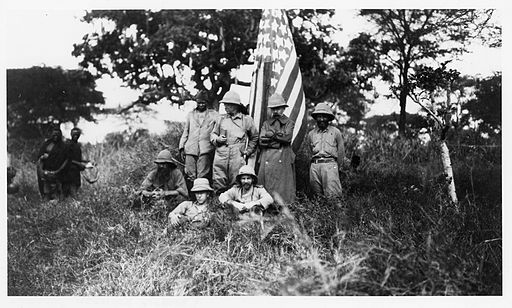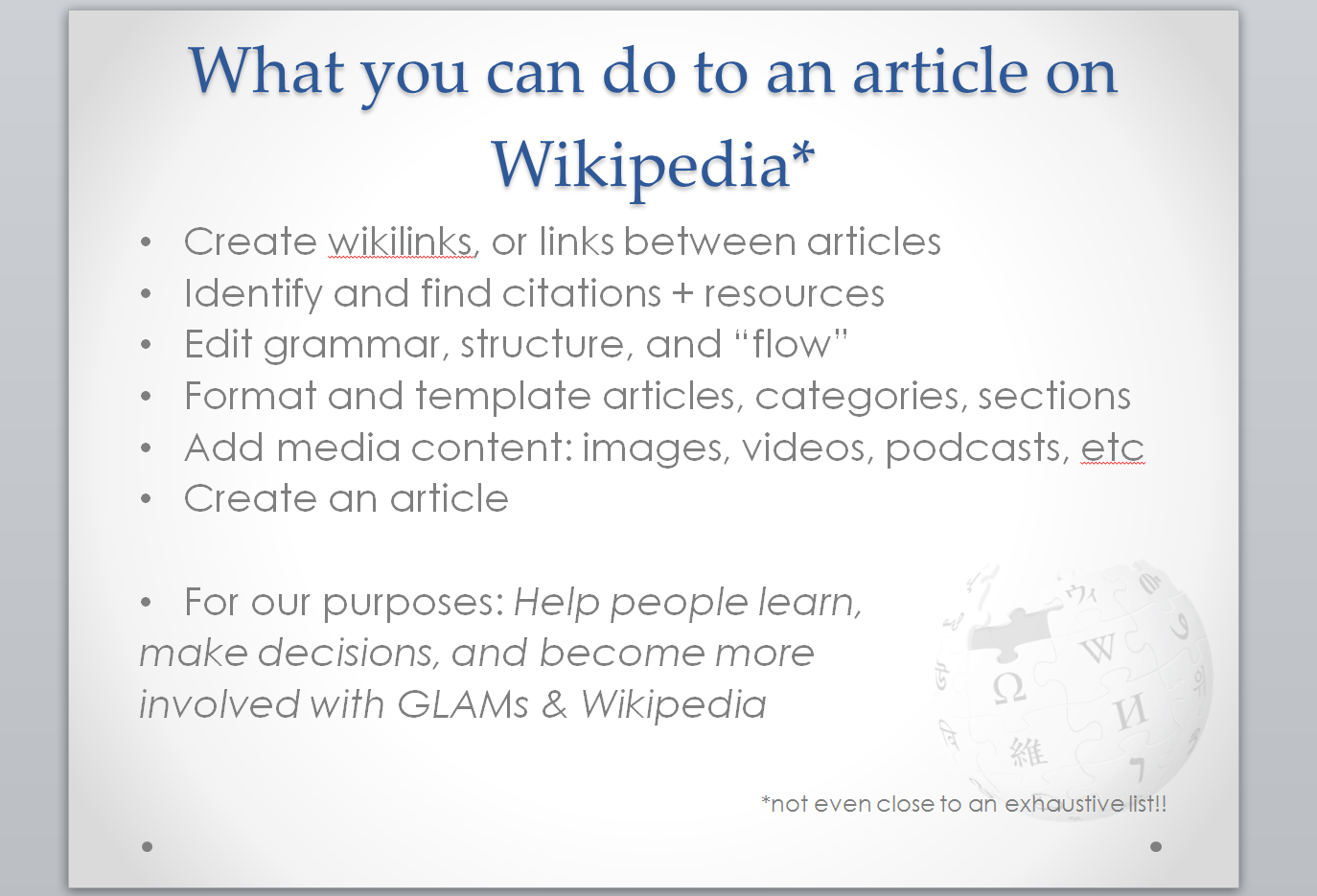Category: Wikipedia
Active Audiences: SI Archives and Women in Science
Smithsonian Institution Archives audiences are actively solving mysteries surrounding Women in Science.
Over the last months, I have been privileged to learn first-hand the ways in which Smithsonian Institution Archives (SIA) is taking engagement with audiences to the next level.
By actively listening to quick-thinking audiences and continuing to expand articles about Women in Science on Wikipedia, SIA staff have been able to
- identify previously unknown women in science and highlight arc-welding success,
- learn more about women in research positions at the University of Chicago, and
- bring attention to a record-setting pilot through the Wikipedia Did You Know? main page feature

Watch for more about #Groundbreakers – women who have made massive contributions to science and technology – every Wednesday through The Bigger Picture blog and connect with SIA on Facebook for more.
These are success stories from engagement and crowdsourcing and offer interesting take-aways for sustaining collaborative activities around cultural heritage collections.
Click through to read more in my post at The Bigger Picture, Smithsonian Institution Archives’ blog.
Working around the Shutdown

Sharing opportunities to engage with Smithsonian collections and distribute knowledge during the U.S. government shutdown which closed to the public all federal institutions including the Smithsonian Institution and its facilities
On Tuesday, with the shutdown of the U.S. government, many of the greatest FREE opportunities to experience science, art, culture, and technology have CLOSED indefinitely. An extremely simplified version of events: without federal funding, the Smithsonian Institution buildings must close, services end, and federal staff face furlough. It should be noted that many national parks and other locations that share cultural heritage stories are also closed to visitors.
The Smithsonian’s current slogan is “seriously amazing” and it could not be more accurate as a description of the breadth and depth of events, research, and access to information. As with many large-scale institutions, there are controversies and gaps in representation – though work continues to address these issues while improving access to physical and digital Smithsonian Institution collections.

In my fieldwork, most apparent in each exchange with staff, volunteers, and researchers in different units: every unit is engaged in passionate pursuit of its goals and energetically seeking to engage with its audience(s). These folks are advocates for learning and clearly agree on:
- the primacy of the distribution of knowledge
- the need to craft better and more dynamic experiences in person and remotely through digital spaces
- their desire to collaborate and share their enthusiasm for their work and
- the need to make collections more widely available (find ways around restrictions)
With such passionate stewards, it seems such a misfortune for visitors to Washington, D.C. (and NYC and affiliate locations) that opportunities for learning and exploration are not available…
Or are they?? The doors may be locked and lights turned off, but all this knowledge cannot be contained by physical barriers!
BARRIERS OR NOT: GET BUSY!
In the interim of government shutdown, let’s explore ways you can engage with Smithsonian Institution collections and materials, whether hosted by SI or other digital repositories.

There are still plenty of opportunities to transcribe and review content at the Smithsonian Digital Volunteers Transcription Center – try your hand transcribing Carl Heinrich’s fieldnotes on butterflies or tackle John Reed Swanton’s detailed English-Alabama and Alabama-English vocabulary cards. You’ll find plenty more to do at the Transcription Center, especially reviewing fellow participants’ transcripts!
You can view truly astounding images on Flickr in albums and photostreams from the Smithsonian Astrophysical Observatory, Biodiversity Heritage Library (BHL), Encyclopedia of Life (EOL), and Smithsonian Institution Archives (SIA).
If you want to help develop Smithsonian Institution knowledge AND view detailed images at the same time, perhaps adding machine tags to images in the EOL and BHL Flickr albums is up your alley. Here are the instructions – you are welcome to add machine tags or even tag as you would typically do on Flickr.
You can also to participate in a data mining research sprint in early February 2014 as a part of pioneering efforts to mine Encyclopedia of Life and the Biodiversity Heritage Library – and learn more about the free access to biodiversity resources. Download the new mobile app, M-EOL, on iTunes or Google Play; earn points as you roll the dice and travel across continents, dynamically mapping relationships between different plant and animal species.
There are on-going opportunities to help build and share knowledge in Wikipedia through Smithsonian collections. Find to-do lists for several museums and archives like SIA and Archives of American Art (AAA) and get editing!
You can explore Freer-Sackler Asian art exhibitions through their website or explore selections hosted by the Google Cultural Institute. Find more details about collections on view and held by the Cooper-Hewitt, National Design Museum and the Hirshhorn Museum and Sculpture Garden – there are so many pieces to admire (and analyze) in these listings!
Want to learn more about what’s happening in related spaces? Check out the weekly round-ups and Link Love posts at the blogs of different units, including Smithsonian Institution Archives Bigger Picture blog.
Education and outreach sites including the Smithsonian Latino Center and the apps and Google+ hangouts hosted by the Smithsonian Asian Pacific American Center have regional, national, and cultural foci on intersections and daily experiences.
If you’ve got a head for researching more, consider exploring archives and collections with finding aids at the Archives of American Art, Smithsonian Institution Archives, the National Anthropological Archives (an AMAZING series of collections!), Anacostia Community Museum, and the Archives Center at the National Museum of American History.
You can also see rich interrelated content from Smithsonian on Tumblr – this is a fantastic chance to develop those webs of knowledge through relationships of cultural heritage, scientific, and artistic content. Check out Smithsonian, Archives of American Art, Smithsonian Libraries, and the Smithsonian Latino Virtual Museum.
While the #shutdown is on-going, Smithsonian social media will not be populated with new information; now is the time to catch up on what you’ve missed!
Connect with Smithsonian Institution museums, archives, galleries and libraries here – from each unit’s presence on Facebook, Pinterest, Twitter, YouTube, and Instagram, and more. Keep up-to-date with any announcements or changes to open status at the the main Smithsonian Facebook page and @smithsonian on Twitter.
That’s merely a drop in the bucket of Smithsonian digital activities – there are so many opportunities to learn AND share the knowledge you’ve developed. If you have other suggestions for this list, such as a favorite app or Smithsonian online activity, please share your thoughts in the comments!
**Featured image for this post of Francis Davis Millet (1846-1912) at work in his studio, courtesy Archives of American Art
Summarizing Outcomes: Expeditions & Explorers Wikipedia Edit-a-thon

This post summarizes the outcomes and experience of the June 21 Expeditions & Explorers Wikipedia Edit-a-thon, co-hosted by Smithsonian Institution Archives (SIA) and National Museum of Natural History (NMNH) for Field Book Project materials.
We believe the event helped to advance freely available knowledge by harnessing the power of the GLAM-wiki relationship. As a reminder, GLAM stands for Galleries, Libraries, Archives, and Museums and the cultural heritage collections that they steward. The advancing elements of the Expeditions & Explorers event were:
- catalyzing diffusion of knowledge through article creation,
- interlinking of existing articles, subjects, and categories,
- sharing and highlighting the accessibility of GLAM resources, including finding aids and digitized texts and images
- uploading Smithsonian Institution collections images to Wikimedia Commons
These tasks serve to improve Wikimedia projects, Wikipedia, as well as GLAM-Wikipedia relationships in several ways.
First, it offered participants a dynamic experience for experienced and inexperienced editors and civilian and museum professionals to bring a variety of skills and knowledge bases to play in unlocking the power of the crowd.
Secondly, the event activities were focused on learning, playing, and working with cultural heritage and scientific materials. This included an exclusive special collections tour and curated discussion and exposure to electronically available resources which allowed participants to understand the diversity of and relationships between Smithsonian Institution collections.
Finally, participants shared their experiences with others through social media; highlighting the ways in which they were having fun, while working on and exploring Wikipedia and the new transcription center. This can only encourage other to participate in future events.
Event Goals
The event was a success in relation to all of the stated goals. Here are several examples of specific ways in which the five goals were achieved:
1. “To encourage inexperienced editors and show them how they can contribute to Wikipedia”
Event participants included five new, inexperienced editors. Our event focused on showing them how they can contribute to Wikipedia
- through an editing tutorial
- helping them establish a Wikipedia user account
- providing best practice tips
- encouraging open discussion of how, when, and why to perform certain tasks on Wikipedia – as with this slide from the best practice tips
2. “To improve a selection of Wikipedia articles related to scientists and expeditions”
- We identified five existing articles about scientists and expeditions and asked participants to improve these articles.
- We also identified four expeditions and scientists who were not represented on Wikipedia and asked participants to help make articles for them.
- This resulted in expansion of seven existing articles and creation of four new articles, as well as wikilinking between existing and new articles, for a more robust web of knowledge
Updated Articles:
- Theodore Roosevelt
- A. S. Hitchcock
- Mary Agnes Chase
- Edward Palmer (botanist)
- Edgar Alexander Mearns
- United States and Mexican Boundary Survey
- Edmund Heller
Newly created Articles
3. “To make Smithsonian-held materials more openly linked”
- Within our Expeditions & Explorers to-do list, we provided Smithsonian Institution resources and electronic records
- We linked at least 15 Smithsonian Institution materials within and to at least nine articles.
4. “To test a new transcribing tool to make our field books more findable and useful”
We invited participants to test the Smithsonian Digital Volunteers Transcription Center and also gathered feedback and discussed the tool with participants
5. “To increase awareness of the research resources freely available through libraries, archives, and museums”
- We believe we achieved this goal not only through the pre-event work in providing resources for articles and the during-event work of editing from specific GLAM resources,
- But also by tweeting about and sharing progress on our event goals during and after the event, with further reports to follow
See posts by my fellow edit-a-thon facilitators Carolyn Sheffield and Effie Kapsalis for perspectives and observations on the edit-a-thon; the Field Book Project blog and the SIA Bigger Picture blog, respectively. The next steps for my analysis include moving through the work to explore the collaborative production of knowledge occurring around these materials – then developing the next Wikipedia edit-a-thon event.
Remember, you can always participate in Wikipedia edit-a-thons remotely – many events are happening daily and “anyone can edit,” so please join in and help build knowledge where you can.
Featured image via Wikimedia Commons (public domain, held with SIA)
Editors Unite: Expeditions & Explorers
On Friday, I was pleased to co-host Expeditions & Explorers – a Wikipedia edit-a-thon bringing new and experienced editors together with focus on materials from the Field Book Project.
Below are the slides I used to introduce a few of our participants to editing on Wikipedia. Rather than a pure “How-to,” the slides reflect “How to think, plan, and execute your edits.” I welcome feedback and suggestions – send me your best practice tips for editing on Wikipedia!
This Wikipedia edit-a-thon was a smashing success! We created four new articles, fleshed out existing articles, introduced new people to the Wikipedia project, exchanged a lot of best practice tips and resources. We also had an amazing lunch, courtesy of grant money from Wikimedia DC (thank you!). I hope the participants enjoyed themselves, developed skills, and learned more about the scientists and expeditions. A more detailed review of our work is in the works, so watch this space…
The Field Book Project is a joint Smithsonian Institution Archives and National Museum of Natural History initiative that is focused on preserving and digitizing field notes from scientists and researchers. The overall mission of the initiative is “to create one online location for scholars and others to visit when searching for field books and other field research materials.” Also find more information from Smithsonian Institution Archives.
Transcription beyond Description at SIA
Last Tuesday, I shared some of the work I’ve been doing at Smithsonian Institution Archives (SIA) through their The Bigger Picture blog. Find out how I’ve been researching engagement and ways audiences can help weave webs of knowledge with SIA collections through the link or here.

